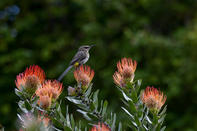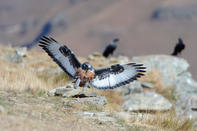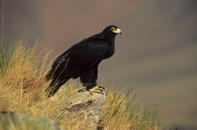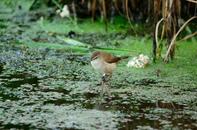For The Bird Watchers
Birdwatchers are in for a treat when birding in the Western Cape. The bearded vulture (Lammergeyer), an endangered species in southern Africa found only in the Drakensberg/Maluti massif, was once numerous throughout the mountains of the western Cape.

Another species that is endangered in the Cape is, ironically, the Cape vulture, with the only breeding colony being at Potberg in the De Hoop Nature Reserve.
Forest and Fynbos Birds

For our purposes, we can distinguish between the forest and montane fynbos species — for these are the two main habitats dealt with — and, to a lesser extent, shore birds of the southern coast. Most conspicuous of the fynbos species is the Cape sugarbird, with its streamer tail feathers and long, curved bill.
Similar but smaller species are the sunbirds, most numerous of which is the orange-breasted sunbird. This is a warbler-sized bird with a brilliant orange and blue breast and a blue-black head. It is a jittery bird that won't stay long in one place, flitting around and probing protea, erica, and other blooms with its slender curved beak.
Other sunbirds are the lessor collared one of similar size, and the malachite sunbird, a larger bird with a narrow elongated tail. In the forests, you should see small Cape battises, robins, sombre bulbuls, doves, and the occasional red-breasted sparrowhawk hunting above the canopy. The shores are home to different species of seagull, terns, oystercatchers and the like.
Birds of Prey

Jackal buzzards are perhaps the most common medium-sized birds of prey, their elegant black-and-white wings with a black trailing edge, fan-shaped grey tail, buff chest and spotted belly being diagnostic in flight. Rock kestrels are small raptors which are common in the high mountain areas. Their striped dark-brown-and-white tails, speckled brick-red bodies and wide, lightly striped and spotted wings make them easy to identify.
On the lower and middle slopes, especially on the southern and eastern ranges, black harriers are likely to be seen. They are unmistakable, with stark black-and white wings and bold black and white striped tails. They hunt by flying low and lazily over the slopes, often alighting on the ground, in the typical harrier fashion.
Birds that Rock

In rocky areas, there are four main types of bird likely to be seen. The first is the Cape rockjumper, whose habits make identification fairly easy. It has a buff-coloured belly, chocolate-brown head with prominent white beard, patchy brown crown and neck, and a buff rump. The rockjumper is a thrush-sized bird that jumps about rocks on long legs.
Next is the ground woodpecker, a starling-sized woodpecker with spotted olive and yellow-green plumage and a bright-red rump that is only conspicuous in flight. They are well camouflaged on rocks, which they tend to hide behind if people approach, although their harsh, sawing call easily gives them away.
The Cape and Sentinel Rock Thrushes are hard to tell apart: males have blue-grey heads and orange bodies, while the females' heads are spotted orange-brown. The Sentinel rock thrush is slightly the smaller of the two, the males have the blue-grey head-colour extending down the back and wing tops, and the female has a whiter chest than the Cape rock thrush. Their habits and habitats are otherwise much the same. Raptors are not common in the area, but a few species are conspicuous.
Most impressive are the Black Eagles which, although nowhere numerous, are likely to be seen throughout the higher mountains — including the Peninsula. These birds will soar above you, often to beyond your own limit of vision and at great speed, or circle in wider and wider turns until they swoop away to hunt something a little smaller. If you are lucky, a breeding pair will entertain you with a display of fine aerobatics; swooping, turning and tumbling with great agility and obvious enthusiasm.
The Cape's Seedeaters

Canaries and seedeaters are numerous, and the species include the sparrow-like protea seedeaters, Cape buntings with their distinctive black and white head stripes, the attractive grey-yellow Cape canaries that live in large flocks and often in the company of other seedeaters, and the Cape siskins - small endemic birds that forage in bushes or on the ground, in small groups. They are easily recognized by the white dots on the tips of their tails.
The rank fynbos is the habitat for warblers of various kinds, but all fall under the description of 'lbj' (short for 'little brown jobs'), a term used by birders to describe the many infuriatingly hard identification of species of similar-coloured, similar-sized birds. There are grassbirds and neddickys, cisticolas and prinias, warblers and titbabblers... but you'll have to go to some other source to help you further.
 SouthAfrica.co.za provides informative, educational content on many South African bird species that orthologists and bird-watchers would enj...
SouthAfrica.co.za provides informative, educational content on many South African bird species that orthologists and bird-watchers would enj... Self drive routes from Cape Town invite visitors to the Mother City to experience the natural splendour, fun activities and scenic attractio...
Self drive routes from Cape Town invite visitors to the Mother City to experience the natural splendour, fun activities and scenic attractio...